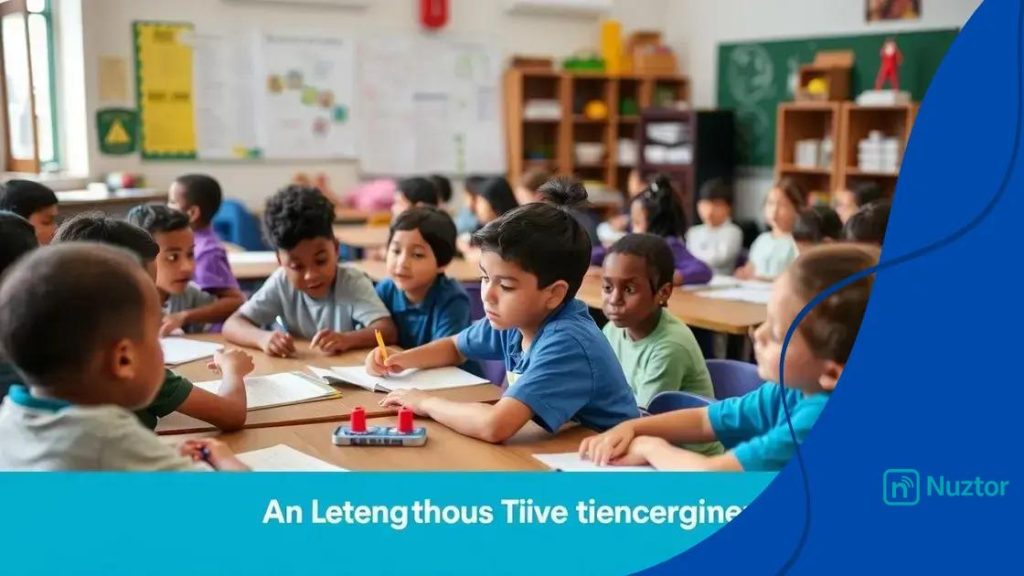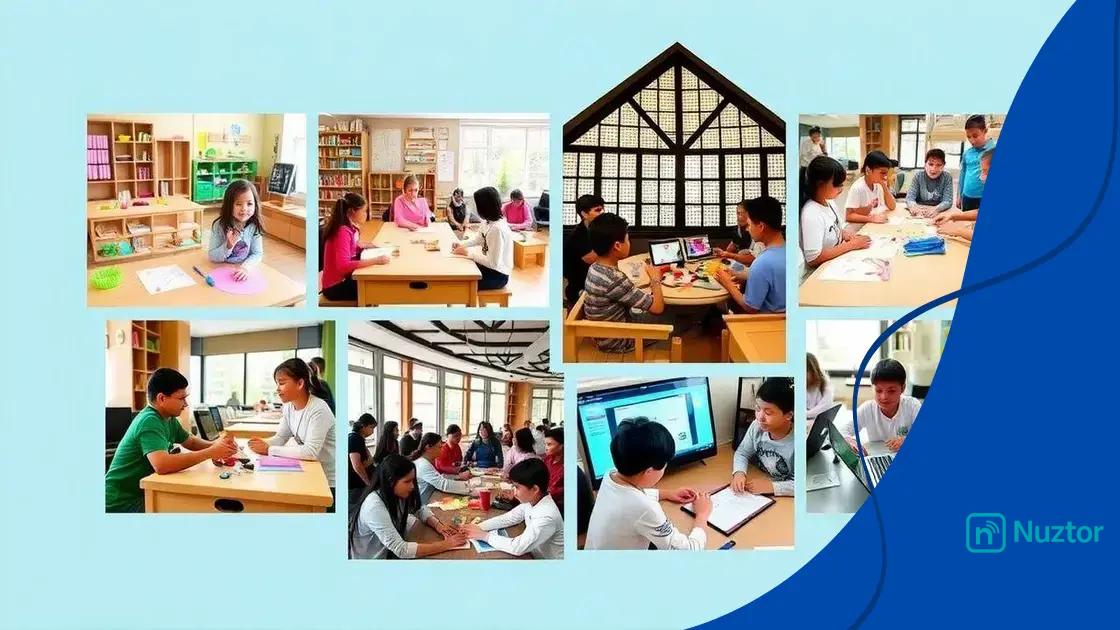Alternative education pathways: unlocking new opportunities

Alternative education pathways, such as Montessori and Waldorf models, provide personalized learning experiences that enhance engagement and foster student success in a supportive environment.
Alternative education pathways are changing the way we think about learning. Have you ever wondered how these options can change your life? In this article, we dive into various alternatives that might just fit your needs and aspirations.
Understanding alternative education pathways
Understanding alternative education pathways can open doors to unique learning experiences. These pathways challenge traditional models by providing distinct approaches and options tailored to individual needs.
Various Options Available
Many types of alternative education exist, each offering different benefits. It’s essential to explore these diverse approaches to identify what works best for you or your child.
- Montessori schools focus on independent learning and hands-on experiences.
- Waldorf education emphasizes creativity and imagination.
- Online learning platforms provide flexible timings and self-paced study.
- Homeschooling allows parents to customize education to their child’s learning style.
These methods encourage exploration and critical thinking, making education more engaging. Each alternative has its philosophy, intent on fostering a love for learning. For instance, in a Montessori setting, children choose their activities, promoting self-motivation and independent thought. On the other hand, Waldorf schools integrate arts and crafts in the curriculum, nurturing creativity.
Benefits of Alternative Education
Alternative pathways also provide tailored educational experiences that can significantly affect student engagement. Students thrive in environments that suit their learning preferences. When they connect with their education, they often perform better academically and develop a genuine interest in learning.
Choosing the right alternative education pathway can seem overwhelming at first. However, taking time to understand your options is crucial. Researching schools, programs, and philosophies can provide essential insights.
In conclusion, alternative education pathways present exciting options for both educators and students. By exploring these diverse methods, learners can discover what resonates best with them, paving the way for rewarding educational journeys.
Benefits of choosing alternative education
Choosing alternative education comes with numerous benefits that can positively impact a student’s learning experience. Understanding these advantages is essential for parents and students alike.
Personalized Learning
One of the main benefits of alternative education is personalized learning. Students can progress at their own pace, which boosts their confidence and motivation. Unlike traditional classrooms, alternative education often allows for customized learning plans tailored to each student’s strengths and needs.
- Adaptation to individual learning styles.
- Flexibility in study schedules.
- Opportunities for hands-on and experiential learning.
Such approaches help students grasp concepts better and make learning more enjoyable. When students engage in topics that resonate with them, they become more invested in their education.
Enhanced Engagement
Another significant benefit is enhanced student engagement. In an alternative learning environment, students often participate actively in their education. This environment promotes critical thinking and the application of knowledge, turning learning into an interactive activity.
When students feel connected to what they’re learning, they are more likely to retain information and develop a passion for discovering new topics. Engaged learners tend to excel as they contribute actively to discussions and projects.
Furthermore, alternative education often integrates real-world experiences into the curriculum. This practical approach allows students to see the relevance of their studies in everyday life. Programs that include community service, internships, or field trips enrich the learning process.
Supportive Communities
Lastly, alternative education settings often foster strong supportive communities. Students typically find themselves in smaller class sizes, allowing for deeper relationships with teachers and peers. Such environments create a sense of belonging, which can be essential for emotional well-being.
Stronger support networks encourage students to express themselves without fear of judgment. This emotional safety helps foster creativity and self-discovery, leading to personal growth.
Popular models of alternative education

When exploring alternative education, it’s important to understand the popular models available today. Each model offers unique benefits and approaches to learning that can cater to different student needs.
Montessori Education
The Montessori model emphasizes hands-on learning and independence. In this environment, children engage with a variety of materials that facilitate exploration and self-discovery. This model encourages students to learn at their own pace while developing problem-solving skills.
- Focus on individual learning styles.
- Students choose their activities and work independently.
- Emphasis on mixed-age classrooms, promoting collaboration.
This method empowers students, building confidence and fostering a lifelong love for learning.
Waldorf Education
Waldorf education is another significant model that integrates arts and academics. This approach nurtures creativity while maintaining a structured curriculum. Students engage in artistic activities such as painting, music, and drama, connecting these experiences to academics.
Waldorf schools aim to develop well-rounded individuals who can think critically and express themselves creatively. The emphasis on community and social responsibility prepares students for active participation in society.
Project-Based Learning
Another popular model is project-based learning, where students learn by engaging in real-world projects. This experiential approach encourages collaboration and critical thinking. Students work in teams to solve problems, often related to their interests.
This method not only fosters a deeper understanding of subjects but also develops essential life skills, such as communication and teamwork.
Online Education Platforms
Online education continues to grow in popularity, offering flexibility and convenience. Students can access high-quality resources and courses from home or anywhere with an internet connection. Many online platforms allow students to learn at their own pace, making education more accessible to various learners.
While online education differs from traditional settings, it provides unique opportunities for self-directed learning and can be tailored to suit individual needs.
How to find the right program
Finding the right alternative education program can feel overwhelming, but with the right approach, it becomes easier to navigate. Start by identifying what educational goals are most important for you or your child.
Assess Your Needs
Begin with a self-assessment to understand your specific requirements. Consider factors like learning style, interests, and any challenges faced in traditional settings. Knowing these aspects will help narrow your search for suitable programs.
- Evaluate whether hands-on or theoretical learning is preferred.
- Identify subjects or activities that ignite passion.
- Consider any special needs or accommodations required.
This evaluation is crucial in guiding you towards programs that resonate well with the student’s learning style.
Research Available Programs
Once you identify your needs, start researching various educational models. Look for options like Montessori, Waldorf, and online platforms. Each has its unique approach, and understanding these will help you make informed decisions.
Utilizing online resources and reading reviews can provide valuable insights. Speaking to other parents or students can also help gauge the effectiveness of certain programs. Ask specific questions about the curriculum, teacher qualifications, and student support systems.
Visit Programs and Ask Questions
When you’ve narrowed down your options, it’s time to visit the programs you’re considering. Observing the environment will give you a first-hand impression of the atmosphere and teaching style.
During your visit, ask about their approach to learning, how they support students, and their philosophy on education. Don’t hesitate to talk to teachers and administration, as they can offer deep insights into the program’s daily operations.
Gathering this information will equip you with the knowledge needed to evaluate if the program aligns with your needs.
Trust Your Instincts
Finally, trust your gut feelings. After visiting programs and gathering necessary information, consider how each program makes you feel. The right fit should feel comfortable and supportive. Your intuition is valuable in making a choice that meets educational needs.
Success stories of alternative education
Success stories from alternative education highlight how diverse approaches can lead to meaningful learning experiences. Many students thrive outside traditional systems, finding joy in their educational journeys.
Real-Life Examples
Consider the story of Emma, a student who struggled with conventional learning methods. After switching to a Montessori school, Emma flourished. The hands-on learning environment allowed her to explore subjects at her own pace. She developed a passion for science through engaging experiments and projects.
- Emma now participates in science fairs and has received awards for her projects.
- Her confidence grew as she found her unique learning style.
- She has become a strong advocate for hands-on education.
Emma’s journey illustrates how alternative settings can transform learning outcomes for students.
Impact of Waldorf Education
Another inspiring story comes from the Wilson family, whose son, Noah, thrived in a Waldorf program. Initially, Noah struggled in traditional school due to its rigid structure. In the Waldorf environment, he was encouraged to express his creativity through art, music, and storytelling.
This model nurtured his emotional and social skills, allowing Noah to develop a holistic view of education. His parents noticed significant changes in his attitude towards learning, and today, he is a confident high school student actively involved in community projects.
Success in Online Learning
Online education has also produced remarkable success stories. Sarah, an aspiring artist, found her calling through an online art program while facing challenges with face-to-face instruction. She was able to connect with mentors from around the world, expanding her skills and artistic vision.
With the flexibility of online courses, Sarah built a portfolio that gained traction in the art community. Now, she showcases her work in local galleries and runs her own online art classes, inspiring other young artists.
These real success stories demonstrate that alternative education pathways can lead to fulfilling and impactful lives, allowing students to discover their strengths and pursue their passions.
FAQ – Frequently Asked Questions about Alternative Education Pathways
What are alternative education pathways?
Alternative education pathways refer to non-traditional methods of schooling that cater to diverse learning styles and needs, such as Montessori, Waldorf, and online programs.
How can I choose the right alternative education program for my child?
Begin by assessing your child’s learning style, interests, and any challenges they face in traditional settings. Research different models, visit programs, and trust your instincts.
What are the benefits of alternative education?
Benefits include personalized learning experiences, enhanced engagement, supportive communities, and opportunities for real-world application of knowledge.
Can alternative education lead to successful outcomes?
Yes, many students in alternative education programs have flourished, showcasing their strengths and passions, which can lead to successful life outcomes.